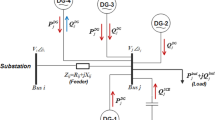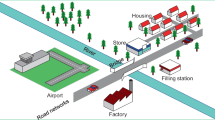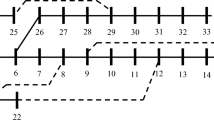Abstract
This paper presents a method based on an optimal power flow (OPF) procedure to determine the maximum Hosting Capacity (HC) of Electric Vehicles (EV) that can be supported by a distribution network. With a focus on the injection control of reactive power, it is possible to maximize the penetration of EV. The presented method is based on linearized power flow equations, allowing a significant reduction in the computational processing times. Two comparisons are presented. The first one is between a nonlinear and a linear OPF method. Second one, it is comparative analysis between legacy iterative (non-optimized) method of HC and the proposed method. The method is applied on the IEEE 13 node test feeder circuit showing its effectiveness and acceptable performance. Results demonstrate that the implemented method enhances the HC measured against a legacy HC method and decrease the computational time measures against nonlinear optimization methods.
Similar content being viewed by others
Abbreviations
- L :
-
System lines
- B :
-
System buses
- \(L_i\) :
-
Lines connected to the bus i
- \(B_i\) :
-
Buses for connection to electric vehicles
- \(g_{ij}\) :
-
Conductance on the line ij
- \(b_{ij}\) :
-
Susceptance on the line ij
- \(PL_{ij}\) :
-
Active power flow from node i to node j
- \(QL_{ij}\) :
-
Reactive power flow from node i to node j
- \(\varDelta \hat{v}_i \) :
-
Approximation of the deviation in the voltage magnitude in system without losses
- \(P_{G_0}\) :
-
Active power in interconnection point with the sub-transmission system
- \(Q_{G_0}\) :
-
Reactive power in interconnection point with the sub-transmission system
- \(PL_{ij}^{Max}\) :
-
Maximum active power flow from node i to node j
- \(QL_{ij}^{Max}\) :
-
Maximum reactive power flow from node i to node j
- \(v_{i}^{Max}\) :
-
Maximum voltage magnitude in the node i
- \(v_{i}^{Min}\) :
-
Minimum voltage magnitude in the node i
- \(v_{i}\) :
-
Voltage magnitude in the node i
- \(\varDelta v_{i}\) :
-
Deviation in the voltage magnitude in the node i
- \(\theta _{i}\) :
-
Voltage angle in the node i
- \(\varDelta \theta _{i}\) :
-
Deviation in the voltage angle in the node i
- \(P_{i}\) :
-
Active power injected into the node i
- \(Q_{i}\) :
-
Reactive power injected into the node i
References
Harrison G, Thiel C (2017) An exploratory policy analysis of electric vehicle sales competition and sensitivity to infrastructure in Europe. Technol Forecast Soc Change 114:165–178
Putrus G, Suwanapingkarl P, Johnston D, Bentley E, Narayana M (2009) Impact of electric vehicles on power distribution networks. In: Proceeding of the 2009 IEEE vehicle power and propulsion conference. IEEE, pp 827–831
Yilmaz M, Krein PT (2012) Review of the impact of vehicle-to-grid technologies on distribution systems and utility interfaces. IEEE Trans Power Electron 28(12):5673–5689
Xiao H, Huimei Y, Chen W, Hongjun L (2014) A survey of influence of electrics vehicle charging on power grid. In: Proceeding of the 2014 9th IEEE conference on industrial electronics and applications. IEEE, pp 121–126
Bollen MH, Hassan F (2011) Integration of distributed generation in the power system, vol 80. Wiley, Hoboken
Bollen M, Rönnberg S (2017) Hosting capacity of the power grid for renewable electricity production and new large consumption equipment. Energies 10(9):1325
Fernandez D, Pedraza S, Celeita D, Ramos G (2015) Electrical vehicles impact analysis for distribution systems with thd and load profile study. In: Proceeding of the 2015 IEEE workshop on power electronics and power quality applications (PEPQA). IEEE, pp 1–6
Bakhshinejad A, Tavakoli A, Moghaddam MM (2020) Modeling and simultaneous management of electric vehicle penetration and demand response to improve distribution network performance. Electr Eng 103(1):325–340
Ovalle A, Hably A, Bacha S, Ramos G, Hossain J (2016) Escort evolutionary game dynamics approach for integral load management of electric vehicle fleets. IEEE Trans Ind Electron 64(2):1358–1369
Ferro G, Laureri F, Minciardi R, Robba M (2018) An optimization model for electrical vehicles scheduling in a smart grid. Sustain Energ, Grids Netw 14:62–70
Tan KM, Ramachandaramurthy VK, Yong JY (2016) Integration of electric vehicles in smart grid: a review on vehicle to grid technologies and optimization techniques. Renew Sustain Energy Rev 53:720–732
Mohsenian-Rad H, Stewart E, Cortez E (2018) Distribution synchrophasors: pairing big data with analytics to create actionable information. IEEE Power Energy Mag 16(3):26–34
Dubey A, Santoso S (2017) On estimation and sensitivity analysis of distribution circuit’s photovoltaic hosting capacity. IEEE Trans Power Syst 32(4):2779–2789
Davoudi M, Cecchi V, Agüero JR (2016) Network reconfiguration with relaxed radiality constraint for increased hosting capacity of distribution systems. In: Proceeding of the 2016 IEEE power and energy society general meeting (PESGM). IEEE, pp 1–5
Cundeva S, Bollen M, Schwanz D (2016) Hosting capacity of the grid for wind generators set by voltage magnitude and distortion levels. In: Mediterranean conference on power generation, transmission, distribution and energy conversion (MedPower 2016). Institution of Engineering and Technology. https://digitallibrary.theiet.org/content/conferences/10.1049/cp.2016.1062
Patsalides M, Makrides G, Stavrou A, Efthymiou V, Georghiou GE (2016) Assessing the photovoltaic (PV) hosting capacity of distribution grids. In: Mediterranean conference on power generation, transmission, distribution and energy conversion (MedPower 2016). https://doi.org/10.1049/cp.2016.1051
Zhao J, Wang J, Xu Z, Wang C, Wan C, Chen C (2017) Distribution network electric vehicle hosting capacity maximization: a chargeable region optimization model. IEEE Trans Power Syst 32(5):4119–4130
Etherden N, Bollen MH (2011) Increasing the hosting capacity of distribution networks by curtailment of renewable energy resources. In: Proceeding of the 2011 IEEE trondheim PowerTech. IEEE, pp 1–7
Alturki M, Khodaei A (2018) Proceeding of the increasing distribution grid hosting capacity through optimal network reconfiguration. In: 2018 North American power symposium (NAPS). IEEE, pp 1–6
Stetz T, Marten F, Braun M (2012) Improved low voltage grid-integration of photovoltaic systems in Germany. IEEE Trans Sustain Energy 4(2):534–542
Nunna HK, Azibek B, Khamitov A, Jamwal PK, Rathore AK, Doolla S (2020) Increasing hosting capacity of distribution networks by microgrid reactive power management. In: 2020 IEEE international conference on power electronics, smart grid and renewable energy (PESGRE2020). IEEE, pp 1–6
Olvera JP, Green T, Junyent-Ferre A (2018) Using multi-terminal dc networks to improve the hosting capacity of distribution networks. In: Proceeding of the 2018 IEEE PES innovative smart grid technologies conference Europe (ISGT-Europe). IEEE, pp 1–6
Deuse J, Benintendi D, Agrell P, Bogetoft P (2005) Power system and market integration of der, the eu-deep approach. In: Proceeding of the CIRED 2005-18th international conference and exhibition on electricity distribution. IET, pp 1–4
Bourgain G, Deuse J, Galant S, Vafeas A, Bercq G, Alvarez, C (2009) Integrating distributed energy resources in today’s electrical energy system. ExpandDER
Bollen M, Häger M. Power quality: interactions between distributed energy resources, the grid, and other customers. In: 1st International conference on renewable energy sources and distributed energy resources, Brussels, Belgium, 1–3 December. Institution of Engineering and Technology. https://digitallibrary.theiet.org/content/conferences/10.1049/cp.2016.1062
Cherkasova L, Ponnekanti SR (2000) Optimizing a “content-aware” load balancing strategy for shared web hosting service. In: Proceeding of The 8th international symposium on modeling, analysis and simulation of computer and telecommunication systems (Cat. No. PR00728). IEEE, pp 492–499
Schwaegerl C, Bollen M, Karoui K, Yagmur A (2005) Voltage control in distribution systems as a limitation of the hosting capacity for distributed energy resources. In: Proceeding of the IET CIRED conference. IET, pp 1–5
Haesen E, Minne F, Driesen J, Bollen M (2005) Hosting capacity for motor starting in weak grids. In: 2005 International conference on proceeding of the future power systems. IEEE, pp 6–pp
Bollen M, Yang Y, Hassan F (2008) Integration of distributed generation in the power system-a power quality approach. In: Proceeding of the 2008 13th international conference on harmonics and quality of power. IEEE, pp 1–8
Menniti D, Merlo M, Scordino N, Zanellini F (2012) Distribution network analysis: a comparison between hosting and loading capacities. In: 2012 international symposium on proceeding of the power electronics, electrical drives, automation and motion (SPEEDAM). IEEE, pp 926–933
Rodriguez-Calvo A, Cossent R, Frías P (2017) Integration of pv and evs in unbalanced residential lv networks and implications for the smart grid and advanced metering infrastructure deployment. Int J Electr Power Energy Syst 91:121–134
Cundeva S, Mateska AK, Bollen MH (2018) Hosting capacity of lv residential grid for uncoordinated ev charging. In: 2018 18th international conference on proceeding of the harmonics and quality of power (ICHQP). IEEE, pp 1–5
Smith J, Rylander M (2012) Stochastic analysis to determine feeder hosting capacity for distributed solar pv, Electric Power Research Inst., Palo Alto, CA, Tech. Rep 1026640, 0885–8950
O’Connell A, Taylor J, Smith J, Rogers L (2018) Distributed energy resources takes center stage: a renewed spotlight on the distribution planning process. IEEE Power Energy Mag 16(6):42–51
Koehler E, Brown E, Haneuse SJ-P (2009) On the assessment of Monte Carlo error in simulation-based statistical analyses. Am Stat 63(2):155–162
Newton S, Smith V (1992) Methods of analysing risk exposure in the cost estimates of high quality offices. Constr Manag Econ 10(5):431–449
Momoh JA (2008) Electric power system applications of optimization. CRC Press, Boca Raton
Martí JR, Ahmadi H, Bashualdo L (2013) Linear power-flow formulation based on a voltage-dependent load model. IEEE Trans Power Deliv 28(3):1682–1690
Ahmadi H, Martı JR, von Meier A (2016) A linear power flow formulation for three-phase distribution systems. IEEE Trans Power Syst 31(6):5012–5021
Dharmakeerthi C, Mithulananthan N, Saha T (2014) Impact of electric vehicle fast charging on power system voltage stability. Int J Electr Power Energy Syst 57:241–249
Alturki M, Khodaei A, Paaso A, Bahramirad S (2018) Optimization-based distribution grid hosting capacity calculations. Appl Energy 219:350–360
D. T. F. W. Group and IEEE (2010) IEEE 13 node test feeder. In: IEEE PES distribution system analysis subcommittee’s. Institution of Engineering and Technology. http://ewh.ieee.org/soc/pes/dsacom/testfeeders/feeder13.zip
Al-Shetwi AQ, Sujod MZ (2018) Grid-connected photovoltaic power plants: a review of the recent integration requirements in modern grid codes. Int J Energy Res 42(5):1849–1865
Ahmed H (2015) Reactive power and voltage control in grid-connected wind farms: an online optimization based fast model predictive control approach. Electr Eng 97(1):35–44
Rohouma W, Balog RS, Peerzada AA, Begovic MM (2018) Capacitor-less d-statcom for reactive power compensation. In: 2018 IEEE 12th international conference on compatibility, power electronics and power engineering (CPE-POWERENG 2018). IEEE, pp 1–6
Al-Shetwi AQ, Sujod MZ, Ramli NL (2015) A review of the fault ride through requirements in different grid codes concerning penetration of pv system to the electric power network. ARPN J Eng Appl Sci 10(21):9906-9912
Author information
Authors and Affiliations
Corresponding author
Additional information
Publisher's Note
Springer Nature remains neutral with regard to jurisdictional claims in published maps and institutional affiliations.
Rights and permissions
About this article
Cite this article
Avila-Rojas, A.E., De Oliveira-De Jesus, P.M. & Alvarez, M. Distribution network electric vehicle hosting capacity enhancement using an optimal power flow formulation. Electr Eng 104, 1337–1348 (2022). https://doi.org/10.1007/s00202-021-01374-7
Received:
Accepted:
Published:
Issue Date:
DOI: https://doi.org/10.1007/s00202-021-01374-7















